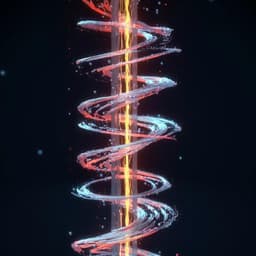
Engineering and Technology
A machine learning approach to map crystal orientation by optical microscopy
M. Wittwer and M. Seita
Discover a groundbreaking machine learning technique for high-throughput crystal orientation mapping in metal alloys, pioneered by Mallory Wittwer and Matteo Seita. This innovative approach, demonstrated on Inconel 718 specimens from additive manufacturing, leverages directional reflectance microscopy, enabling easier mapping and extending to various alloys and manufacturing processes.
~3 min • Beginner • English
Introduction
The study addresses the need for high-throughput crystallographic orientation mapping in polycrystalline materials, especially where microstructure varies over large areas such as in metal additive manufacturing. Conventional EBSD, while accurate, is limited by throughput, field of view, and specimen size. Optical approaches offer speed and coverage but typically require physics-based models and have been demonstrated primarily on simple, pure materials. The authors propose a data-driven alternative that uses directional reflectance microscopy (DRM) and a convolutional neural network (EulerNet) to infer grain orientation in complex engineering alloys, specifically Inconel 718 produced by directed energy deposition, thereby aiming to overcome the limitations of EBSD for large-area, high-throughput applications.
Literature Review
Prior work established that orientation information can be inferred optically by analyzing intensity and polarization changes upon reflection, or by examining etch-induced surface topography, with DRM belonging to the latter. Existing DRM-based orientation indexing relied on physics-based models and was limited to pure crystalline solids where optical signals could be analytically related to crystallography. Metallographic literature documents etchants that produce crystallographic features on many metals/alloys, enabling optical methods. Deep learning, particularly CNNs, has proven effective for image-like data and has been applied to EBSD pattern indexing. However, extending optical orientation mapping to complex, multi-phase engineering alloys remained an open challenge due to difficulties in modeling their optical responses; this motivates a data-driven machine learning approach.
Methodology
Materials and specimen preparation: Ten Inconel 718 ("1718") rectangular specimens (24 mm × 24 mm × 12–18 mm) were fabricated by directed energy deposition (DED) using varied process parameters (laser power, scan speed, layer height, powder feed rate) to induce diverse microstructures. Post-build heat treatment followed AMS5663: 60 min at 950 °C, 8 h at 750 °C (age hardening), and 8 h at 690 °C. Specimens were sectioned along the XY plane (perpendicular to build direction Z), ground (SiC 320→4000 grit), polished to mirror finish (colloidal silica), and etched in Kalling's 2 at room temperature for 10 min to reveal δ (Ni3Nb) platelets, which are crystallographically related to the γ FCC matrix: (111)γ//(010)δ and [101]γ//[100]δ; δ habit planes align with (111)γ.
DRM acquisition: A stereomicroscope (Olympus SZ6145, 3× objective), monochrome CMOS camera, and white LED light source were used. The light elevation θ was varied from 15° to 65° in 10° steps (6 elevations), and azimuth φ from 0° to 355° in 5° steps (72 azimuths). For each (θ, φ), an image was captured, yielding stacks of 6 × 72 images; image resolution downscaled from 2448 × 2048 to 1224 × 1024 to reduce memory load. Reflectance was normalized using a uniform white reflector to compensate for uneven illumination. The DRM signal per pixel is a 2D array of size 6 × 72 containing reflection intensities across illumination angles.
EBSD and registration: EBSD measurements were performed on a JEOL 7600F SEM with an Oxford Nordlys 2 S detector at 15 mA, 20 kV, and 15 µm step size. DRM and EBSD fields of view were co-registered using the TV-L1 optical flow method (scikit-image implementation) to associate each DRM reflectance pattern with a ground-truth orientation from EBSD.
Data selection and augmentation: To reduce redundancy and registration errors, grains were segmented using the LRC-MRM algorithm; grains smaller than 6 pixels in diameter were excluded. For each remaining grain, the pixel farthest from boundaries (via Euclidean distance transform) was selected, averaging ~68,850 data points for training per split. Data augmentation included random azimuthal rotations of reflectance patterns and multiplicative intensity scaling by a normal factor N(1, 0.2), values clipped to [0,1].
Model architecture (EulerNet): A CNN maps the 6 × 72 reflectance input to three Euler angles. Architecture: Conv2D (3×3, 64 filters, stride 1, ReLU) → MaxPool2D (2×2, stride 1) → Conv2D (3×3, 64, ReLU) → MaxPool2D (2×2, stride 1) → Flatten (size 1152) → Dense 784 (ReLU) → Dense 384 (ReLU) → Dense 3 (Euler angles). Total trainable parameters: 1,219,523.
Loss and symmetry handling: The objective minimizes disorientation between predicted and EBSD orientations considering FCC symmetry (24 operators). The exact disorientation metric involves arccos of trace-based expressions and is non-differentiable over full domain; hence, a differentiable approximation was used: L(g1,g2) = mins∈S {√3 − tr[g1 S g2−1]}, which is monotonic with true disorientation near small angles. Training used Adam optimizer; mini-batch size 50; 100 epochs; learning rate selected via log-grid search (10−1 to 10−2), best at 3.1 × 10−3. Training time ~1 h 32 min on Intel i7-9750 CPU.
Cross-validation and testing: Ten-fold specimen-level cross-validation: nine specimens for training, one held out entirely for testing per split. Performance evaluation primarily used selected central pixels to mitigate registration errors; full pixel-level comparisons provided in supplementary materials.
Anomaly detection: To detect out-of-distribution DRM inputs (e.g., due to equipment bias, preparation errors, underdeveloped δ), PCA was applied to training reflectance data; the first two principal components were standardized (mean 0, std 1), and their average defined a unitless z-score as an anomaly indicator. High z indicates deviation from training distribution; spatial z-maps highlight local/global anomalies such as lack-of-fusion or regions lacking δ precipitates. Equipment calibration steps are advised to minimize systematic bias; transfer learning is proposed when calibration is insufficient.
Key Findings
- EulerNet produces optical inverse pole figure (IPF) orientation maps from DRM that are visually almost identical to EBSD references, including X, Y, and Z directions, on specimens not used in training.
- Quantitatively, across ten cross-validation splits, the median disorientation error between predictions and EBSD ground truth at grain centers is 6.7° ± 0.8°.
- Orientation-axis-specific mean errors: Dx = 6.5° ± 0.6°, Dy = 6.4° ± 0.6°, Dz = 5.8° ± 0.6°, indicating slightly lower error out-of-plane (Z) than in-plane (X,Y).
- Error is mostly uniform across orientations, with a small increase near the out-of-plane (111) orientation, likely linked to six-fold symmetry in corresponding reflectance patterns.
- The method is robust to significant microstructural variability caused by different DED process parameters across specimens.
- Anomaly detection via PCA-derived z-score effectively flags both local defects (e.g., lack-of-fusion) and global bias (e.g., underdeveloped or absent δ precipitates), enabling preemptive data screening.
- While less accurate than EBSD (~0.6°), the optical method offers substantially higher throughput and larger fields of view, suitable for large specimens and materials libraries.
Discussion
The findings demonstrate that a data-driven CNN (EulerNet) can decode directional reflectance signals produced by etch-induced δ platelets to recover crystallographic orientation in a complex engineering alloy (Inconel 718). This addresses the research need for high-throughput, large-area orientation mapping where EBSD is impractical due to throughput and size constraints. Performance is strong (median ~6–7°), with error uniformity across orientations and slightly better out-of-plane accuracy, consistent with reduced mounting-induced misalignment out of plane. The model generalizes across diverse microstructures induced by varying DED parameters, indicating robustness and practicality for process-structure studies. Discrepancies with EBSD are attributed in part to unavoidable registration inaccuracies and equipment limitations in DRM acquisition; improving these could reduce error further. The anomaly detection framework provides a pragmatic safeguard against out-of-distribution inputs, enabling reliable deployment across different specimens and potentially different hardware with calibration or transfer learning. Overall, DRM plus EulerNet is best viewed as complementary to EBSD: not a replacement for fine-scale, high-precision analysis, but a powerful tool for rapid, large-area orientation mapping in research and industrial settings, particularly in additive manufacturing.
Conclusion
This work introduces EulerNet, a convolutional neural network that infers grain orientations from directional reflectance microscopy data to achieve high-throughput optical orientation mapping in Inconel 718. The approach circumvents the need for physics-based signal modeling, achieves median disorientation errors around 6.7°, and yields maps visually comparable to EBSD while offering substantially greater throughput and field of view. The method is robust to microstructural variability and is supported by an anomaly detection scheme to identify biased or out-of-distribution data. Future work should focus on enhancing DRM equipment precision, refining neural network design and training, mitigating dataset registration errors, and applying transfer learning for cross-instrument consistency. Broadening to other alloys and sharing trained models, detailed preparation protocols, and calibration guidelines across the community could establish a scalable foundation for high-throughput optical orientation microscopy and accelerate process-structure-property exploration.
Limitations
- Accuracy remains lower than EBSD (~6.7° vs ~0.6° typical for EBSD).
- Evaluation error is likely overestimated due to imperfect spatial registration between DRM and EBSD datasets and manual mounting misalignments.
- DRM measurement accuracy depends on equipment factors (light collimation, camera optics, motor accuracy) and variability in etch-induced surface features.
- Model performance assumes well-developed δ precipitates; inadequate etching or microstructures lacking δ features degrade results.
- Potential systematic bias from differing DRM apparatuses; requires calibration or transfer learning.
- Slightly higher errors near the (111) out-of-plane orientation.
- Method currently validated on Inconel 718; extension to other materials requires dataset collection and model retraining.
Related Publications
Explore these studies to deepen your understanding of the subject.







